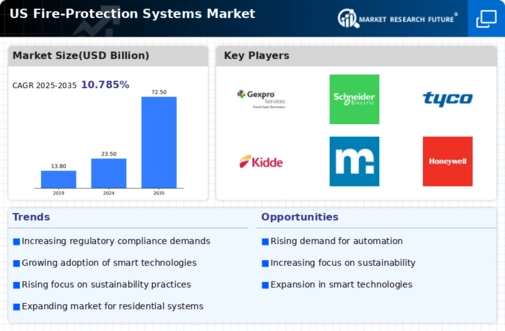The US Fire-Protection Systems Market is an essential segment of the overall safety and security industry, characterized by a constant evolution towards advanced technologies and sustainable solutions. Market players are competing vigorously not only in the product offerings but also in service capabilities and customer engagement strategies. With increasing concerns regarding fire safety regulations and a growing emphasis on workplace safety, the market has witnessed a surge in demand for sophisticated fire protection solutions across various sectors, including commercial, residential, and industrial.
In this highly competitive landscape, players are leveraging innovation, strategic partnerships, and customer-centric approaches to enhance their market presence and brand loyalty.
Gexpro Services has established a strong footing in the US Fire-Protection Systems Market through a robust distribution network and a diversified product portfolio that meets the varied needs of customers. The company has carved out a competitive edge by focusing on providing high-quality fire protection equipment and solutions alongside exceptional customer service. Gexpro Services excels in delivering efficient supply chain solutions, which allows it to respond quickly to market demands and project timelines.
This agility in operations has solidified its reputation as a reliable partner in fire protection systems across the United States, catering primarily to sectors requiring compliance with stringent fire safety regulations.
Bosch Security Systems stands out in the US Fire-Protection Systems Market with its comprehensive range of advanced fire detection and alarm systems, combining cutting-edge technology and innovation. The company has a significant market presence, bolstered by a strong commitment to research and development, allowing it to introduce state-of-the-art solutions tailored to meet the evolving demands of various industries. Bosch Security Systems emphasizes its strengths in high-quality and reliable products, coupled with unmatched technical support, making it a preferred choice among clients.
In addition to its innovative product line, the company has strategically pursued mergers and acquisitions to enhance its market capabilities and increase its footprint, solidifying its position as a key player in the landscape of fire protection systems in the US. The integration of advanced technology, such as IoT and smart building solutions within their offerings, further reinforces Bosch Security Systems' commitment to driving safety and reliability in fire protection.




















